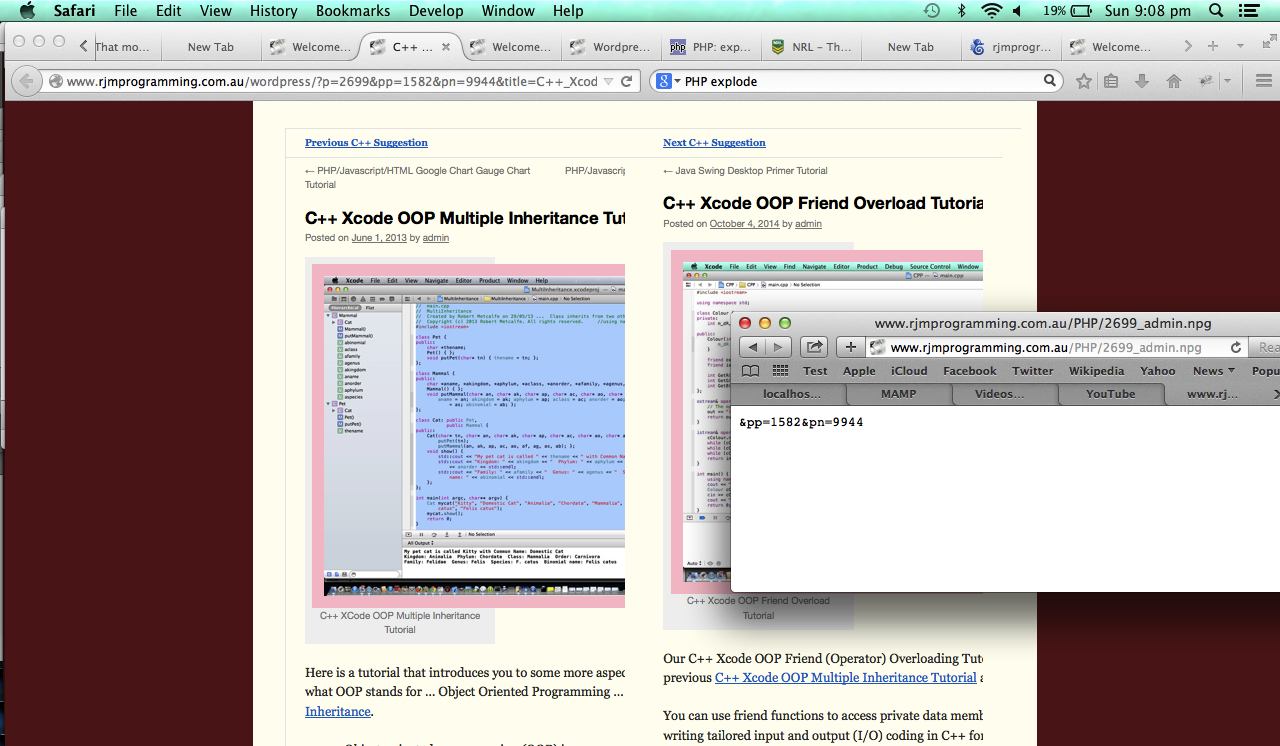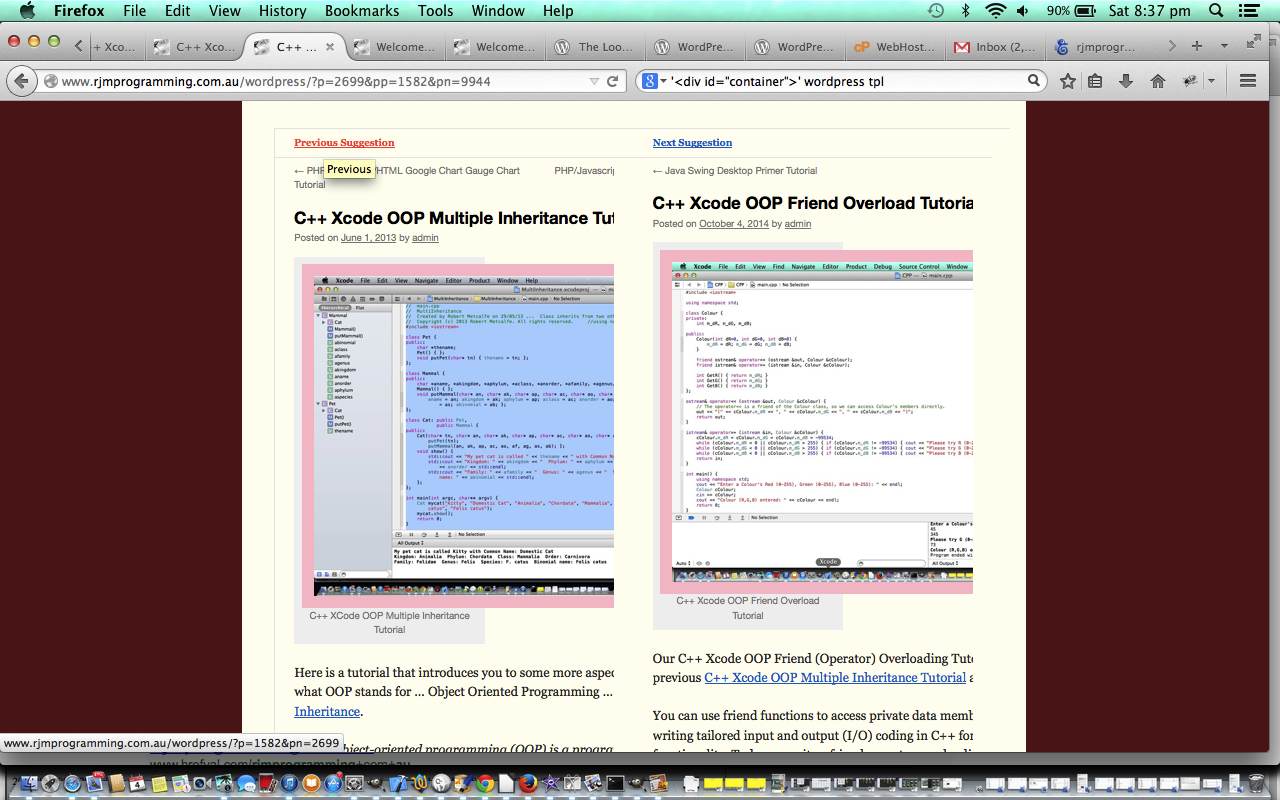As a follow up to … “This WordPress blog could benefit from a directed order of tutorials studied for a particular topic. This may not suit everybody, but it may suit some, and if a system is created that is optional, that can sit on top of what functionality is already there, all the better.” … how about we set up the means by which the user or the administrator of this blog (I knew it) can control what order tutorials for a range of subjects or topics could be?
If you’re designing this (and please don’t get any ideas that there is just the way suggested here) you set a “get parameters” way to express the fact that you want this “guided” Course Design help but don’t know what is a good tutorial to come before nor after, and what logic paths, in order …
- accept last recorded &pp=[blog id of previous blog post of interest to current one] and &pn=[blog id of next blog post of interest to current one] advice for this current blog posting from this user (ie. use cookies)
- accept last recorded &pp=[blog id of previous blog post of interest to current one] and &pn=[blog id of next blog post of interest to current one] advice for this current blog posting from this client using their IP address
- accept last recorded &pp=[blog id of previous blog post of interest to current one] and &pn=[blog id of next blog post of interest to current one] advice for this current blog posting from the administrator of this blog
- accept last recorded &pp=[blog id of previous blog post to current one] and &pn=[blog id of next blog post to current one]
- disregard display of previous and next suggested tutorials
… to follow in order to come up with the blog posting display that you end up with.
Let’s just first concentrate on options 3 and 4 and 5 above … how about we use &pp=&pn= to mean that if no previous and/or next tutorial information is found anywhere you should (5) “disregard display of previous and next suggested tutorials”, whereas if you specify &pn=&pp= to mean that if no previous and/or next tutorial information is found anywhere you should (4) “accept last recorded &pp=[blog id of previous blog post to current one] and &pn=[blog id of next blog post to current one]”.
This sounds a silly detail to worry about, but the fact is, if this detail is sorted out, this whole “guided” Course Design system can be automated from this domain’s landing page‘s tutorial dropdown, or any other dropdown you want to design to direct people to this WordPress Blog’s tutorials.
And where could we intervene to fix this up? Well, well, well (three holes in the ground … chortle, chortle) … you’d have to be an avid follower of this blog to remember, but the blog posting called Extended Linux Crontab Curl Tutorial would hold the answer to where the most efficient solution to this lies, in adjusting the PHP code called tutorial_options.php here as below …
… to enable an ID= on the links to allow for future Javascript DOM possibilities and a file arrangement for admin and/or IP user based tailoring of previous and/or next blog posting “get” parameters. Future tutorials on this “theme” will look at functionality to maintain and populate these files in a sensible way.
Another question occurs to me. Shouldn’t the name of the proposed Course a blog posting belongs to be part of the display? No, I wouldn’t do that! “Yeah, but who asked you? You’re a cat, remember?” No furry beastings were hurt during the creation of this blog posting.
Is the name of the Course a thing that the Course Designer should designate, or can it be derived from the WordPress blog? This will vary in people’s outlook. Some will be fine for (one of) the WordPress blog posting Category (or Tag?) (names) to suffice, and think I’d be in that camp. But I’m also in the camp that says this could be overridden by a user or administrator defined method … feel a “get parameter” coming on … so let’s see what the adjusted code for the “framework” of these new requirements looks like (the tutorial_options.php needed adjustment for this concept as well) … it panned out to be better to focus on the first word of the blog posting’s title as a better bet for what the Course name could be derived from … the PHP code (snippet) goes into wp-content/themes/twentyten/functions.php off the WordPress Blog’s document root directory …
if ( ! function_exists( 'get_tutorial_topic' ) ) :
/**
* Get tutorial topic (word).
*
* @since October 2014 by RJM Programming
*/
function get_tutorial_topic($thistopic) {
$words = explode(" ", str_replace(" ", "++", str_replace("~~", "#~", $thistopic)));
if (sizeof($words) > 1) {
return " " . $words[0];
}
return "";
}
endif;
if ( ! function_exists( 'previous_next' ) ) :
/**
* Allow for next and previous via &pn= and &pp= respectively.
*
* @since October 2014 by RJM Programming
*/
function previous_next($both = true) {
if (isset($_GET['pp']) || isset($_GET['pn'])) {
$prefix = " id='atop";
if ($both) $prefix = " id='abottom";
$topic = "";
$tget = "";
if (isset($_GET['title'])) {
$tget = "&title=" . $_GET['title'];
$topic = get_tutorial_topic(str_replace("_", " ", $_GET['title']));
} else {
$topic = get_tutorial_topic($post->title);
}
if (strpos(($_SERVER['QUERY_STRING'] . "&"), "&pp=&pn=&") !== false) {
$prefix = $prefix;
} else {
echo "<table style='width:98%; background-color: #F6F5F1;'><tbody><tr>";
if (isset($_GET['pp'])) {
echo "<th><a" . $prefix . "p' target=_blank title='Previous' href='" . str_replace("?" . $_SERVER['QUERY_STRING'], "", $_SERVER['REQUEST_URI']) . "?p=" . $_GET['pp'] . "&pn=" . $_GET['p'] . $tget . "'>Previous" . $topic . " Suggestion</a></th>";
}
if (isset($_GET['pn'])) {
echo "<th><a" . $prefix . "n' target=_blank title='Next' href='" . str_replace("?" . $_SERVER['QUERY_STRING'], "", $_SERVER['REQUEST_URI']) . "?p=" . $_GET['pn'] . "&pp=" . $_GET['p'] . $tget . "'>Next" . $topic . " Suggestion</a><th>";
}
if ($both) {
echo "</tr><tr>";
if (isset($_GET['pp'])) {
echo "<td><iframe src='" . str_replace("?" . $_SERVER['QUERY_STRING'], "", $_SERVER['REQUEST_URI']) . "?p=" . $_GET['pp'] . "#content' width=400 height=800></iframe></td>";
}
if (isset($_GET['pn'])) {
echo "<td><iframe src='" . str_replace("?" . $_SERVER['QUERY_STRING'], "", $_SERVER['REQUEST_URI']) . "?p=" . $_GET['pn'] . "#content' width=400 height=800></iframe></td>";
}
}
echo "</tr></tbody></table>";
}
}
}
endif;
… and you may want to compare this to the code of the previous WordPress Blog Course Design Primer Tutorial as shown below. Today’s explanation of a “live run” is to:
- Access the rjmprogramming.com.au domain Landing Page
- At the tutorial dropdown “motor” down to the tutorial at 20130722 … OOPs (chortle, chortle) … and choose this
- Hopefully … voila (as per live run as was the “live run” from tutorial below + a Course name inclusion functionality improvement so that it is like … live run again) … do the same for 20141006 (today’s) and you don’t get the new functionality, but hopefully it doesn’t cause any bugs (as you change code the top priority should be firstly not to break other parts that used to work, and to proceed successfully with new functionality that works)
Hope to see you again next time.
Previous relevant WordPress Blog Course Design Primer Tutorial is shown below.
This WordPress blog could benefit from a directed order of tutorials studied for a particular topic. This may not suit everybody, but it may suit some, and if a system is created that is optional, that can sit on top of what functionality is already there, all the better.
When you want to add PHP (or HTML, for that matter) functionality, with web work, I personally find the get parameters useful, and this is usually fine as long as the data required of this functionality …
- is not too long
- is not sensitive (ie. not a password or username)
… otherwise it is better to use post parameters or a database or a file arrangement of some sort.
Step one in our Course Design ideas is to introduce two new ideas with two new get parameters, so that:
- &pp=[blog id of previous blog post of interest to current one]
- &pn=[blog id of next blog post of interest to current one]
Here’s a first draft of a PHP snippet of code to use (though over time it may change):
if ( ! function_exists( 'previous_next' ) ) :
/**
* Allow for next and previous via &pn= and &pp= respectively.
*
* @since October 2014 by RJM Programming
*/
function previous_next($both = true) {
if (isset($_GET['pp']) || isset($_GET['pn'])) {
echo "<table style='width:98%; background-color: #F6F5F1;'><tbody><tr>";
if (isset($_GET['pp'])) {
echo "<th><a target=_blank title='Previous' href='" . str_replace("?" . $_SERVER['QUERY_STRING'], "", $_SERVER['REQUEST_URI']) . "?p=" . $_GET['pp'] . "&pn=" . $_GET['p'] . "'>Previous Suggestion</a></th>";
}
if (isset($_GET['pn'])) {
echo "<th><a target=_blank title='Next' href='" . str_replace("?" . $_SERVER['QUERY_STRING'], "", $_SERVER['REQUEST_URI']) . "?p=" . $_GET['pn'] . "&pp=" . $_GET['p'] . "'>Next Suggestion</a><th>";
}
if ($both) {
echo "</tr><tr>";
if (isset($_GET['pp'])) {
echo "<td><iframe src='" . str_replace("?" . $_SERVER['QUERY_STRING'], "", $_SERVER['REQUEST_URI']) . "?p=" . $_GET['pp'] . "#content' width=400 height=800></iframe></td>";
}
if (isset($_GET['pn'])) {
echo "<td><iframe src='" . str_replace("?" . $_SERVER['QUERY_STRING'], "", $_SERVER['REQUEST_URI']) . "?p=" . $_GET['pn'] . "#content' width=400 height=800></iframe></td>";
}
}
echo "</tr></tbody></table>";
}
}
endif;
So where does the code above belong in the WordPress source code? Well, for the TwentyOne theme of this blog, the answer is wp-content/themes/twentyten/functions.php off the WordPress Blog’s document root directory (where PHP functions go, generally).
And the plan will be to call it, for the top and bottom of current posting respectively:
- <?php previous_next(false); ?>
- <?php previous_next(true); ?>
So where does this code go? Well, for the TwentyOne theme of this blog, the answer is, in WordPress terminology, in The Loop, for the particular scenario, and the scenario here is the display of a single WordPress Blog posting, as typically happens via the Search Engine links or relevant dropdown links within this rjmprogramming.com.au domain … and this pans out to be within wp-content/themes/twentyten/single.php off the WordPress Blog’s document root directory … after these two lines of PHP code respectively …
- <?php if ( have_posts() ) while ( have_posts() ) : the_post(); ?>
- <?php endwhile; // end of the loop. ?>
… for these two looks respectively …
Try an example of a live run of the use of this new functionality here at this WordPress Blog … but there is more to do … and we will visit these other “things to do” over time … thanks for visiting … bye for now.
If this was interesting you may be interested in this too.
If this was interesting you may be interested in this too.




